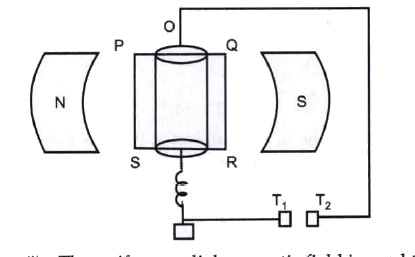Explain, using a labelled diagram, the principle and working of a moving coil galvanometer. What is the function of (i) uniform radial magnetic field, (ii) soft iron core?
Define the terms current sensitivity and voltage sensitivity of a galvanometer. Why does increasing the current sensitivity not necessarily increase voltage sensitivity?
The basic principle of a moving coil galvanometer is that when a current carrying coil is placed in a magnetic field, it experiences a torque.
When the current I is passed through the coil, the torque experienced is given by
τ=NIABsinθ
Where N = No. of turns of the coil,
A = Area of the coil
B = Magnetic field and
θ = Angle between normal of coil and magnetic field

(i) The uniform radial magnetic field is used to make the scale linear.
(ii) The soft iron core increases the strength of the magnetic field.
The current sensitivity is defined as the deflection produced in the galvanometer, when a potential difference of 1 V is applied to the coil.
Thus, voltage sensitivity
(αV)=NBAK=1R
Where R is the resistance.
Increasing the current sensitivity does not necessarily increase the voltage sensitivity as there is an increase in the resistance as well.
Similar Questions
Define current sensitivity and voltage sensitivity of a galvanometer.
Increasing the current sensitivity may not necessarily increase the voltage sensitivity of a galvanometer. Justify.View SolutionDefine current sensitivity and voltage sensitivity of a moving coil galvanometer. How can a galvanometer be made more sensitive?
View Solution
Knowledge Check
- Question 1 - Select One
Sensitivity of a moving coil galvanometer increases as:
Anumber of turns decreasesBnumber of turns increasesCtorsional rigidity increasesDarea of coil decreases - Question 2 - Select One
The sensitivity of a moving coil galvanometer increases with the decrease in
Anumber of turnsBarea of coilCmagnetic fieldDcouple per unit twist - Question 3 - Select One
If the current sensitivity of a galvanometer is doubled, then its voltage sensitivity will be
AdoubledBhalvedCunchangedDfour times
Define the term 'current sensitivity' of a moving coil galvanometer.
View SolutionDescribe the working principle of a moving coil galvanometer. Why is it necessary to use (i) a radial magnetic field and (ii) a cylindrical soft iron core in a galvanometer? Write the expression for current sensitivity of the galvanometer.
View SolutionThe current sensitivity of a galvanometer increases by 20%. If its resistance also increases by 25%, the voltage sensitivity will
View SolutionIf the current sensitivity of a galvanometer is doubled, then its voltage sensitivity will be
View SolutionIn order to increase the current sensitivity of a moving coil galvanometer the
View Solution
